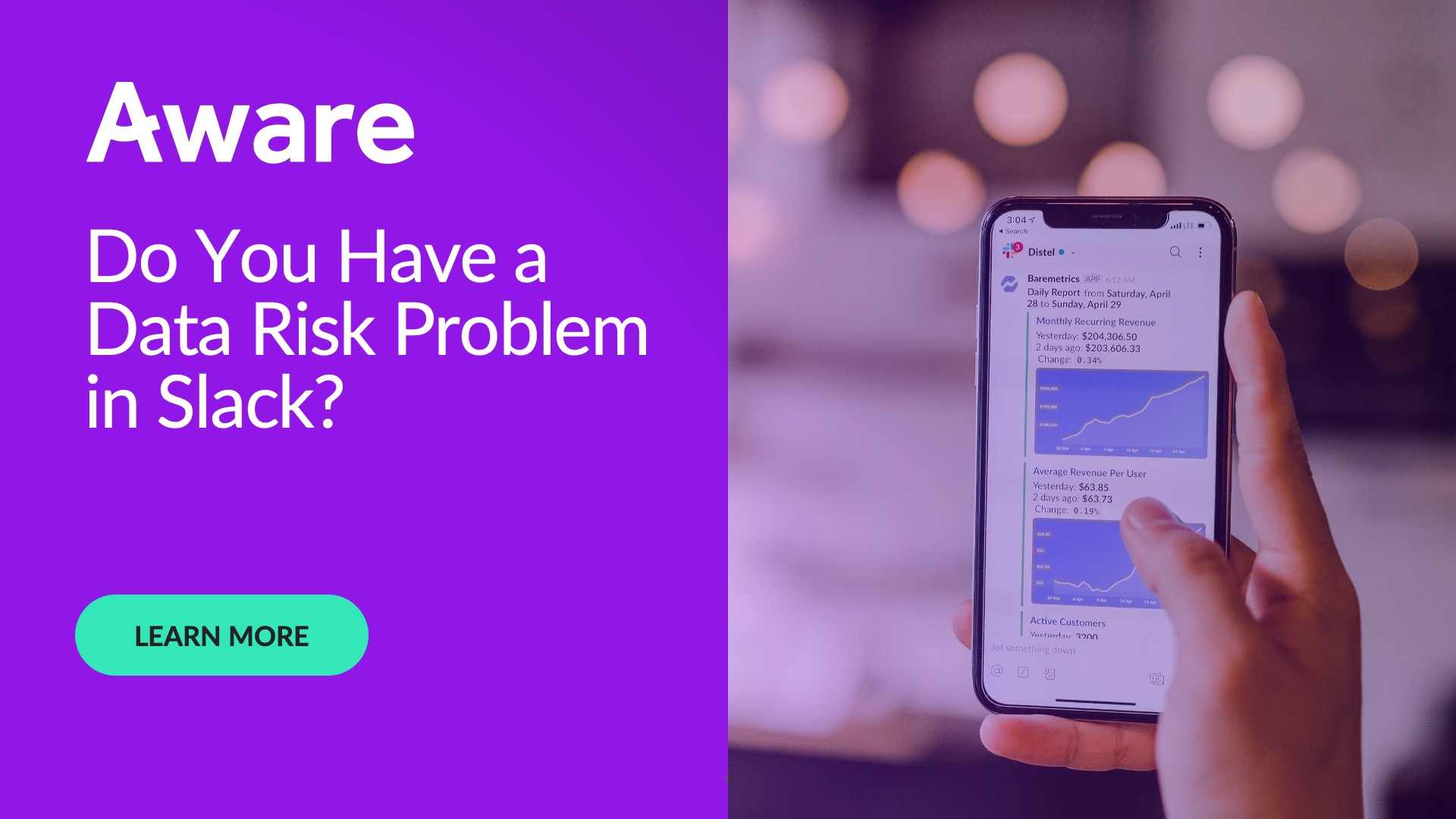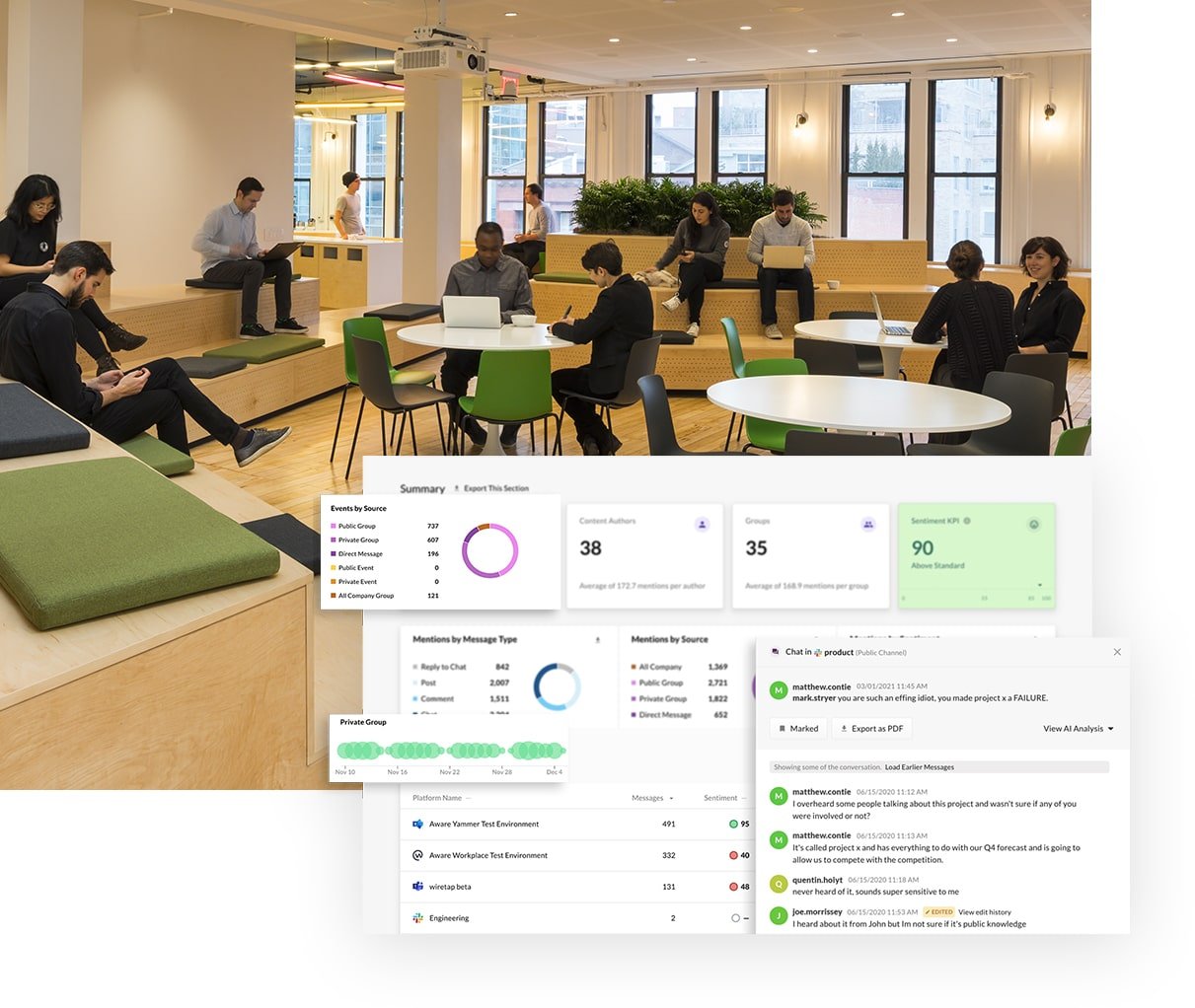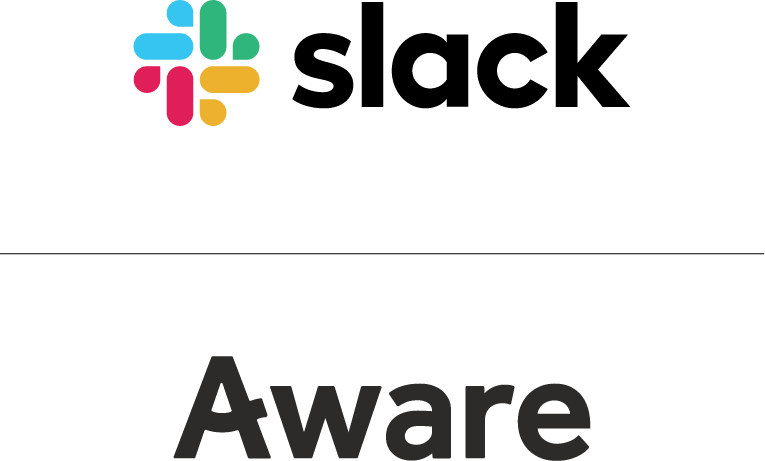Compliance Monitoring for Slack: All You Need to Know
by Aware
As more businesses turn to real-time collaboration tools like Slack to support the modern workflow, security and regulatory compliance is an area of increasing concern for governing bodies and executives alike. This post covers everything workspace administrators need to know about maintaining compliance within Slack and securing their company data to minimize the risk of fines, penalties, and other legislative action.
Contents
- What is compliance monitoring?
- Why is compliance monitoring essential for modern businesses?
- Slack compliance monitoring FAQ
- Is Slack HIPAA compliant?
- Is Slack GDPR compliant?
- Is Slack NIST 800-171 compliant?
- Is Slack CJIS compliant?
- Is Slack approved for DoD use?
- Does Slack have AES 256-bit encryption?
- How does Slack comply with the PCI Security Standards Council?
- What is the difference between Slack and Slack Enterprise Grid?
- What are some of the compliance challenges of using Slack?
- What native compliance controls does Slack have?
- How does Slack protect against phishing and other attacks?
- 4 Steps to reduce security and compliance risks in Slack
- How Aware enables real-time compliance for Slack
What is compliance monitoring?
Compliance monitoring refers to the ongoing process of ensuring that an organization adheres to relevant laws, regulations, and internal acceptable use policies. To do this, companies deploy a range of measures to track and evaluate employee activity within work-sanctioned tools and apps. These measures aim to detect noncompliant or risky behavior and mitigate the risks of regulatory fines and penalties. Effective compliance monitoring helps reduce risk, maintain ethical practices, and safeguard the organization's reputation.
Why is compliance monitoring essential for modern businesses?
With so much of today’s work taking place online in cloud-based tools and across distributed teams, compliance monitoring is more important than ever to protect the sensitive data a company handles. This data can include regulated data such as personal health information (PHI) and payment card industry (PCI) data, as well as intellectual property and other proprietary and confidential information.
In the past, this sensitive and regulated information would have been limited to on-prem solutions such as paper files or closed computer networks, reducing the need for compliance monitoring. With more information flowing freely between devices and applications, businesses must deploy around-the-clock solutions in all the places where their employees work to:
- Protect data and privacy
- Safeguard against cybersecurity risks
- Prevent any violations and associated fines
- Support company culture
Slack compliance monitoring FAQ
Is Slack HIPAA compliant?
Although Slack is not HIPAA compliant out of the box but can be used in ways that support and enforce HIPAA compliance. Learn more about HIPAA compliance in Slack.
Is Slack GDPR compliant?
The GDPR, and related legislations such as CCPA/CPRA, PIPEDA, and LGPD, outline how companies handle the data of individuals, including employees. Slack provides administrators with controls and settings that help to support these legislations in company workspaces. Learn more about GDPR compliance in Slack.
Is Slack NIST 800-171 compliant?
NIST SP 800-171 outlines the procedures that non-federal organizations should follow when handling Controlled Unclassified Information (CUI). Slack is NIST 800-171 certified.
Is Slack CJIS compliant?
The Criminal Justice Information Services Security Policy (CJIS) applies to any organizations that access or handle criminal justice data such as biometrics, case histories, and incident data. It is largely used by first responders and related agencies. Slack is CJIS compliance certified.
Is Slack approved for DoD use?
Government and DoD agencies can use GovSlack, a secure and compliant version of Slack designed for government use. GovSlack is FedRAMP High, DoD SRG IL4, and FIPS 140-2 compliant.
Does Slack have AES 256-bit encryption?
Slack offers a range of security and encryption features, depending on Slack plan tier and administrator settings. These include TLS 1.2 protocols, AES256 encryption, ECDHE_RSA Key Exchange Algorithm, and SHA2 signatures where supported.
How does Slack comply with the PCI Security Standards Council?
Although Slack is not a PCI-certified Service Provider, it does offer security features that admins can implement to protect PCI data within Slack as part of a wider compliance strategy. Slack has also completed the Payment Card Industry Data Security Standard’s Self-Assessment Questionnaire A (SAQ-A).
What is the difference between Slack and Slack Enterprise Grid?
Slack Enterprise Grid is a membership tier of Slack that enables the functionality to take more granular control of a Slack instance to enforce data security and compliance policies. Enterprise Grid users can also connect their Slack instance to third-party compliance, DLP, eDiscovery, and other security tools and apps via API.
What are some of the compliance challenges of using Slack?
Slack is an extremely popular collaboration tool, but it does come with challenges for compliance officers. These include:
- Sensitive data sharing: Employees use Slack to accelerate work by sharing confidential information and files, which are then retained indefinitely within paid Slack instances.
- eDiscovery and search: Finding information within Slack can be challenging, as messages have different visibility settings depending on if they are sent in public channels, private channels, or direct messages.
- Data complexity: The datasets generated by collaboration platforms like Slack are massive—each employee in an average workplace sends 30-40 messages per day, meaning even small Slack instances can contain millions of messages and files.
- Edits and deletions: Slack users (custodians) retain full control over the messages they send and can edit or delete them at any point. This makes it harder for compliance officers to understand when potential breaches might have happened.
- Third-party integrations: Slack connects with thousands of different apps and tools, any of which could increase data security risks by sharing sensitive information. Admins must ensure that any integrations also meet the same compliance standards as Slack.

Read more: Do you have a data risk problem in Slack?
What native compliance controls does Slack have?
Slack supports compliance and infosec teams by providing a number of features and controls to help manage sensitive information within Slack messages. Firstly, Slack is compliant with a range of global security and privacy standards, including ISO 27001, SOC 2, SOC 3, APEC PRP, and APEC CBPR. Further, Slack enables admins to utilize its software is ways that are compliant with major compliance regulations such as GDPR, CCPA/CPRA, HIPAA, FINRA, FedRAMP and more.
To enable compliance for businesses, Slack offers data residency controls that allow admins to choose the geographic region where their data-at-rest is stored. Slack also offers a Data Processing Addendum, which outlines Slack’s obligations and requirements under GDPR, CCPA and similar legislation in relation to processing user data. Collectively, these features can help workspace administrators to support and uphold compliance within Slack. However, they do not provide all the controls required to enforce compliance across the Slack environment.
Compliance within Slack should be reinforced by third-party compliance tools that can monitor Slack messages in real time, backed with regular employee training to limit accidental disclosure of sensitive or restricted information.
How does Slack protect against phishing and other attacks?
Securing Slack against unauthorized access from third-party users is critical to protecting the company data it contains. Examples of data losses and compliance breaches that occurred through Slack include:
- Grand Theft Auto VI footage was leaked after Rockstar Games’ Slack was hacked
- The source code for FIFA 21 and other data was stolen from EA Games via a Slack breach
- A hacker gained access to confidential financial details and account logins from Uber and announced it on their company Slack
Learn how to identify and tackle insider threats in Slack
Slack takes measures to prevent bad actors from accessing business workspaces, such as restricting logins to company-owned accounts and further controlling access via Encryption Key Management. For additional security, Slack also enables two-factor authentication, which can be enforced across the workspace by administrators. Even if 2FA isn’t mandatory, admins and owners must use 2FA when signing into their accounts. Alternatively, admins can require single sign-on (SSO), adding an extra layer of security with an identity provider (IDP) such as Azure Active Directory (now Microsoft Entra ID), Google Workspace (SAML), Okta, or OneLogin.
Alongside native Slack security measures, organizations can connect their Slack instance to third-party applications designed to reduce the risk of malicious attacks. Available solutions include DLP and CASB services to protect data and limit access, and real-time monitoring and alerting software that can detect insider incidents as they occur.
Collectively, these measures can reduce the threat posed by hackers and other bad actors within Slack, but employees should also be routinely trained on how to identify phishing (email) and smishing (SMS) attacks as they occur. The Uber breach, for example, was the result of an MFA fatigue attack, where the hacker repeatedly sends login requests to the employee’s 2FA device until the employee finally approves one.
4 Steps to reduce security and compliance risks in Slack
Step 1: Set clear guidelines for Slack
Any workplace tool should be evaluated for security before use. Proactively establishing acceptable use policies can help employees understand how to use a tool—and what behaviors to avoid. This can reduce noncompliant activities and limit exposure for the organization.
Step 2: Train employees on acceptable use
There’s no point creating policies without also training employees on how to follow them. Don’t bury acceptable use guidance but make training and reminders a regular part of your infosec strategy and deploy a content moderation tool that can support and coach employees in real time.
Step 3: Establish data retention policies
A major component of regulatory compliance is retention. How long companies keep information, and how easily accessibly it is, are key provisions of regulations such as HIPAA, FINRA, and GDPR. Companies must have a plan to institute and enforce retention requirements within Slack.
Step 4: Enable real-time Slack monitoring
Use a tool that can monitor and analyze Slack messages in real time to detect noncompliant and risky activity as it occurs and take corrective action to reduce risk exposure within Slack.
How Aware enables real-time compliance for Slack
Aware makes it easy for administrators to establish and enforce compliance and acceptable use within Slack. Aware’s AI-powered platform was designed to reduce risk and extract value from employee collaboration data in Slack and other tools using proprietary natural language processing (NLP) that surfaces more events with fewer false positives.
As the only Slack vendor approved for both data loss prevention and eDiscovery, Aware provides holistic oversight and control of Slack data, meeting use cases for security, compliance, and infosec teams. Aware connects to Slack via API to capture a complete record of all messages, including revisions and deletions, and stores them in a search-ready archive infused with AI/ML metadata for faster discovery and better contextual analysis of the who, what, where, when, how, and why of security incidents.
Smart automations take immediate action whenever noncompliance and data risks are detected, tombstoning messages for review or automatically coaching employees on acceptable use policies to minimize future violations. Bi-directional retention policies apply equally to both data-in-place and archived Slack data, meaning admins can comply with regulatory need and internal policies in a controlled, defensible way, backed by comprehensive audit logs.
Learn more about how Aware supports Slack compliance
Using Aware, businesses can quickly and easily enforce compliance and acceptable use across Slack and other collaboration tools from a centralized dashboard designed and built to address the unique complexities of this dataset.











